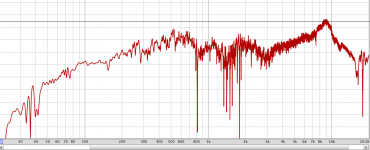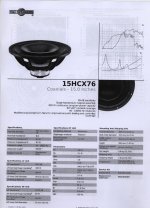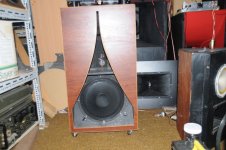Thank you Freddi. It appears the 200Hz drop is a target. The bad news is you will have to increase the external K vent size to at least 78 sqin to hit 200Hz. it also shifts the bass shelf higher up in freq from 60Hz to 70Hz.
Lets hope 180+Hz sounds good enough
Lets hope 180+Hz sounds good enough
Would the K aperture help control break ups and peaks in the 8kHz-10kHz region?
I have a shelf full of 3" and 4" speakers that have 5 to 15dB spikes in that region (seems a constant in the drivers made around here!) and would love to find a way to use them, besides using a notch filter.
They all look more or less like this:
I have a shelf full of 3" and 4" speakers that have 5 to 15dB spikes in that region (seems a constant in the drivers made around here!) and would love to find a way to use them, besides using a notch filter.
They all look more or less like this:
Attachments
It definitely can reduce those peaks - you will have to do trial and error with cutting the profile, start small and enlarge slowly. Add felt on backside of aperture to help clean it up.
I have Karlsonators with 15 inch B&C 15H cx76
They have foam top and bottom but nothing behind the speakers; is it worth adding foam or Felt behind the speakers. What about fibre glass or plastic fibre.
Sound great and super sensitive close to as sensitive as the huge horns I have.
Just wondered if they need extra padding.
Thanks Phil
They have foam top and bottom but nothing behind the speakers; is it worth adding foam or Felt behind the speakers. What about fibre glass or plastic fibre.
Sound great and super sensitive close to as sensitive as the huge horns I have.
Just wondered if they need extra padding.
Thanks Phil
Attachments
maybe having fluffed polyfil in the "stub" is the most important (?) - you could put something on one side panel and the back - not too thick - not sure if it would help.
Would you post some pictures ? did you scale the Karlsonator12 directly ? what are the dimensions? About whre are they tuned ?
I've played with regular K with 18" speakers and of course K15 and have wondered for a long time about a potent Karlsonator15.
That's a cool looking coax
A K-tube can work well - even "in" the coupler per Karlson's "X15" speaker.
Would you post some pictures ? did you scale the Karlsonator12 directly ? what are the dimensions? About whre are they tuned ?
I've played with regular K with 18" speakers and of course K15 and have wondered for a long time about a potent Karlsonator15.
That's a cool looking coax
A K-tube can work well - even "in" the coupler per Karlson's "X15" speaker.
Hello Freddy
Thanks for your reply; I was given the K15's in exchange for an amplifier.
I will take photos and measurements, The original owner had Altek 604's E's I think in the boxes. I never heard the 604's in the K15's,but in the Altek recommended box's, I found the 604's very screechy, I think there is a crossover change that fixes the problem.
Phil
Thanks for your reply; I was given the K15's in exchange for an amplifier.
I will take photos and measurements, The original owner had Altek 604's E's I think in the boxes. I never heard the 604's in the K15's,but in the Altek recommended box's, I found the 604's very screechy, I think there is a crossover change that fixes the problem.
Phil
hi Phil a 604 should sound pretty nice in the classic Karlson. I ran a 604B chassis with "E" cone with the old Altec series crossover scheme and motor run caps. Depending upon amplification, paper and foil caps might have been better.
I assume you have classic Karlson K15 and not "Karlsonator K15"? What kind of crossover do you have on your coaxial?
I assume you have classic Karlson K15 and not "Karlsonator K15"? What kind of crossover do you have on your coaxial?
Karlson
Hi fredi
Thanks
Photo of the speaker I have; this one has the B&C HF15-109. Like the Tannoy uses the cone as the horn. Have been sick on Chemo, so not able to change to the same speaker in each box.
Size in Inches height 3 ft; width 20.5 inches; depth 21 inches
Size in CM; height 92; width, 52cm, depth, 52cm. has 4 extra pieces of wood that can be inserted behind the front? I have never tried them.
I could email the builder, Dave; I am not sure if the speaker is a Karlson or a Karlsonator. Dave went to live in the Daintree forest in Queensland he likes Altecs & Tannoy
I have the circuit for the B&C crossover, but I bought mine ready made from China was cheaper than buying the parts.
I had one 604E never found another so sold it to a friend. Very expensive to buy from the USA + freight.
I use tube amps, have many different types some with High damping some not so high.
Phil
Hi fredi
Thanks
Photo of the speaker I have; this one has the B&C HF15-109. Like the Tannoy uses the cone as the horn. Have been sick on Chemo, so not able to change to the same speaker in each box.
Size in Inches height 3 ft; width 20.5 inches; depth 21 inches
Size in CM; height 92; width, 52cm, depth, 52cm. has 4 extra pieces of wood that can be inserted behind the front? I have never tried them.
I could email the builder, Dave; I am not sure if the speaker is a Karlson or a Karlsonator. Dave went to live in the Daintree forest in Queensland he likes Altecs & Tannoy
I have the circuit for the B&C crossover, but I bought mine ready made from China was cheaper than buying the parts.
I had one 604E never found another so sold it to a friend. Very expensive to buy from the USA + freight.
I use tube amps, have many different types some with High damping some not so high.
Phil
Attachments
That's an odd duck of a Karlson if I may say so. It's not built to factory K15 dimension, as it's taller, narrower and deeper, but seems to be using similar "internals". It also does not appear to be any of the published modern high-aspect designs, though it is in the same vein to a certain extent. The aperture also terminates higher than usual. I guess it's the builder's interpretation or modification, quite interesting really.
What is the speaker on the right side of that picture, with the light cone and yellow surround?
What is the speaker on the right side of that picture, with the light cone and yellow surround?
that is DIFFERENT - very nice and must sound very good. I wonder if the builder has some say on why he made it a bit taller? What are the dimensions of the port?
if you can reach inside the port, what is the distance between the shelf (assuming there is one) and the rear of the cabinet?
Where do the extra pieces attach ?
I would guess the higher damping factor tube amps to sound better on bass control than say a single ended amp with little or no feedback circuit (?)
I have several SE tube amps - my push pull, not used for a long time is a Mesa Strategy 400.
my skinny K18 is about 41.5 inches high - 21.5" wide - 16" deep, has a curved reflector, no front shelf, has a rear shelf/lowpass gap, and sounds very good as a 2-way with internally mounted K-tube or on top as in the picture below. Its just as good or better with the K-tube mounted in that hole right above the 18" woofer. Although thus K18 doesn't go "deep", its bass is quite powerful with very little cone movement.
Your 15" K is a bit larger than my 18" K. The Cetec-Gauss 5181 18 inch Karlson is about 10.5 cubic foot in bulk. mine ~ 8.1CF. Karlson's K18 appeared to be a scaled K15.
18 inch speakers in general tend to be a bit more mellow than 15" running mms in the 50-85g region. My EV18B is pretty bright for an 18 and IIRC, has moving mass around 80g.
IG - - Carl made claims of the coupler altering fs of a speaker by a large amount, thus altering the TS with lower fs / higher qts- I didn't see that but did not have a front coupler by itself to test - what do you think?

my first K18 was a coupler built for a 15 using K's 2nd acoustic transducer patent drawing "Fig.6" as inspiration. It had a bigger reponse hole than K15 at 250 without a front shelf. (perhaps the backwave fill from the side ports needed for a K-tube didn't fill that area as well as a central port like K15 ?) Putting a board in its front made it more like K15 in measurement and sound. I somehow cut a decent ~16" hole - it was impressive and could move air. It was 20" deep, 21" wide, and 32" tall without the base.
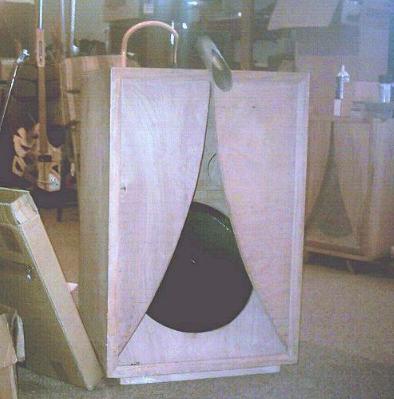
if you can reach inside the port, what is the distance between the shelf (assuming there is one) and the rear of the cabinet?
Where do the extra pieces attach ?
I would guess the higher damping factor tube amps to sound better on bass control than say a single ended amp with little or no feedback circuit (?)
I have several SE tube amps - my push pull, not used for a long time is a Mesa Strategy 400.
my skinny K18 is about 41.5 inches high - 21.5" wide - 16" deep, has a curved reflector, no front shelf, has a rear shelf/lowpass gap, and sounds very good as a 2-way with internally mounted K-tube or on top as in the picture below. Its just as good or better with the K-tube mounted in that hole right above the 18" woofer. Although thus K18 doesn't go "deep", its bass is quite powerful with very little cone movement.
Your 15" K is a bit larger than my 18" K. The Cetec-Gauss 5181 18 inch Karlson is about 10.5 cubic foot in bulk. mine ~ 8.1CF. Karlson's K18 appeared to be a scaled K15.
18 inch speakers in general tend to be a bit more mellow than 15" running mms in the 50-85g region. My EV18B is pretty bright for an 18 and IIRC, has moving mass around 80g.
IG - - Carl made claims of the coupler altering fs of a speaker by a large amount, thus altering the TS with lower fs / higher qts- I didn't see that but did not have a front coupler by itself to test - what do you think?

my first K18 was a coupler built for a 15 using K's 2nd acoustic transducer patent drawing "Fig.6" as inspiration. It had a bigger reponse hole than K15 at 250 without a front shelf. (perhaps the backwave fill from the side ports needed for a K-tube didn't fill that area as well as a central port like K15 ?) Putting a board in its front made it more like K15 in measurement and sound. I somehow cut a decent ~16" hole - it was impressive and could move air. It was 20" deep, 21" wide, and 32" tall without the base.

Last edited:
I brought up the K18(s) as Phil's 15K is an illustration that the original aspect can be varied and its a good way to load some 18" - particularly in subjective outcome vs reflex. Karlson's original aspect might be nearly the best in punch for smaller regular K-type - I'm not positive. GregB's Karlsonator opened up new opportunities vs regular K.
the smallest 15K would be the X15 type and perhaps the best offshoot, Acoustic Control's 115BK. Its quite smooth and would make a nice option vs a midbass horn provided there's some wattage.
It has about the same LF extension as a typical Karlson K12. If sacled 1.2:1 then would be the same bulk as K15 but hold an 18" speaker
a tapped horn , etc. subwoofer would be needed for deep bass

the smallest 15K would be the X15 type and perhaps the best offshoot, Acoustic Control's 115BK. Its quite smooth and would make a nice option vs a midbass horn provided there's some wattage.
It has about the same LF extension as a typical Karlson K12. If sacled 1.2:1 then would be the same bulk as K15 but hold an 18" speaker
a tapped horn , etc. subwoofer would be needed for deep bass

Last edited:
IG - - Carl made claims of the coupler altering fs of a speaker by a large amount, thus altering the TS with lower fs / higher qts- I didn't see that but did not have a front coupler by itself to test - what do you think?
The way I see it, the front chamber of a Karlson contains air which mass-loads the driver to a certain extent. It also typically tunes over an octave over Fb, which "pushes down" the main impedance peak, see below, the blue trace being driver + front chamber only.
Note that the 35L / 115Hz chamber has Ql=3, which I find matches a real-life standard Karlson's response.
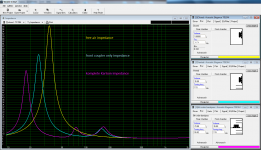
I suppose one would get lower Fs and higher Qt if deriving T/S parameters from the blue impedance profile. I think measuring a PPSL, RiPol sub, U and H frame OB, tapped horn or anything that loads both sides of the driver would reveal something similar.
Last edited:
For kick out of a helmholtz it needs to be as short as possible.
Also the speaker cone should be in close proximity of the inner port opening.
Does that mean that (roughly) an old style vent (a simple rectangular opening, plus baffle thickness) has more "kick" than the usual tube port?
The Karlson coupler technology seems to offer many compelling advantages over other speaker solutions. Does anyone know why it apparently disappeared from the commercial market many decades ago, and has yet to return?
one thing which happened - its alleged that JBL bought some patent and enforced it shutting down one manufacturer. After John Karlson's passing in 1973, it appears his wife sold licenses to multiple parties. Acoustic Control, KK-Audio, Westwood, Transylvania Power Co. and others, all marketed an X15 sized K-coupler. Acoustic made their's regular and also as the BC-2 combo amp.
Karlson's X15, introduced in 1965
PWK published a reasonable graph of K15 (probably loaded with K33 spec woofer) and assume felt "BS" to its claims as did Julian Hirsch. K's claims were based on some loose assumption that input impedance reflected the low frequency extension capability and there were claims K15 would play to "8Hz" (from a turntable feedback incident at one show). That aside, in its range, K15 with the right woofer/coax, is very adept and produces a lot of clean output with very little cone excursion. It doesn't look remarkable graph-wise.
Wolf von Langa is enthusiastic I think about Karlson-tech including the bass coupler but probably feels they are a hard-sell aesthetically. (that would be a non-issue imo with grill cloth and internally mounted K-tube)
there's been a lot written saying the Karlson is the worst speaker ever made. I say in practice, and favorable driver matching, that its one of the best - at least compared to modest sized horn systems.

the X15 derived cabinet sold in the early 1980's was ~27" tall, 20.5" wide and would be 13.5" deep sans wings' inset of ~1.5"

a nicely made "home version" loaded with classic Altec components
using MMJ's constricted transflex model to kludge the 115BK/X15 size coupler to midbass horns about twice the size of the K-coupler one can see that the horn should have the midrange advantage. Fb on the 115BKj is around 53Hz
I think regular Karlson cabinets were sized pretty well - at least the 12" and original 15" model.
GregB's "Karlsonator" variant offers different opportunities - especially with smaller drivers. I wonder if there's one more useful variant?
Karlson's X15, introduced in 1965
An externally hosted image should be here but it was not working when we last tested it.
PWK published a reasonable graph of K15 (probably loaded with K33 spec woofer) and assume felt "BS" to its claims as did Julian Hirsch. K's claims were based on some loose assumption that input impedance reflected the low frequency extension capability and there were claims K15 would play to "8Hz" (from a turntable feedback incident at one show). That aside, in its range, K15 with the right woofer/coax, is very adept and produces a lot of clean output with very little cone excursion. It doesn't look remarkable graph-wise.
Wolf von Langa is enthusiastic I think about Karlson-tech including the bass coupler but probably feels they are a hard-sell aesthetically. (that would be a non-issue imo with grill cloth and internally mounted K-tube)
there's been a lot written saying the Karlson is the worst speaker ever made. I say in practice, and favorable driver matching, that its one of the best - at least compared to modest sized horn systems.

the X15 derived cabinet sold in the early 1980's was ~27" tall, 20.5" wide and would be 13.5" deep sans wings' inset of ~1.5"
An externally hosted image should be here but it was not working when we last tested it.

An externally hosted image should be here but it was not working when we last tested it.
a nicely made "home version" loaded with classic Altec components
An externally hosted image should be here but it was not working when we last tested it.
using MMJ's constricted transflex model to kludge the 115BK/X15 size coupler to midbass horns about twice the size of the K-coupler one can see that the horn should have the midrange advantage. Fb on the 115BKj is around 53Hz
I think regular Karlson cabinets were sized pretty well - at least the 12" and original 15" model.
GregB's "Karlsonator" variant offers different opportunities - especially with smaller drivers. I wonder if there's one more useful variant?
An externally hosted image should be here but it was not working when we last tested it.
An externally hosted image should be here but it was not working when we last tested it.
Last edited:
Xtra chamber - when is it worthwhile ?
adding a chamber at the top, attached to the top of the front coupler, can: add some effective volume; reduce cavity peaking; smooth response.
can the chamber be generalized and scaled as to not require an Akabak model? (we see K peaking pretty much scaled with K8 effects about an octave higher than K15)
fluffed polyfil is sufficient for damping.
when is the addition of the chamber actually helpful?

adding a chamber at the top, attached to the top of the front coupler, can: add some effective volume; reduce cavity peaking; smooth response.
can the chamber be generalized and scaled as to not require an Akabak model? (we see K peaking pretty much scaled with K8 effects about an octave higher than K15)
fluffed polyfil is sufficient for damping.
when is the addition of the chamber actually helpful?

HI freddi
Sorry I have been sick
Thanks for you help!!!
The Speaker with the yellow cone is an 8 inch full range with big magnet made in China.
phil
Sorry I have been sick
Thanks for you help!!!
The Speaker with the yellow cone is an 8 inch full range with big magnet made in China.
phil
hope you're feeling much better - is that a Diatone type clone? - I ended up with LCao F6 6 inch speaker (very nice) as could not find the ferrite 8" model.
sometime, it not too difficult, I'd like to see the insides of your 15" K with the back panel removed. My 41.5" x 21" x 16" K18 plays very nicely with no front shelf and using an internal K-tube. It worked well with a 130g mmx 18" Eminence and now has an EVM18B - I don't like its aesthetics 😱 - I should have tried it with 15" but would like to make a new 15K about 3 foot tall, but not as deep as yours.
Carl said he would test several apertures - radial arc, p=1/q=1.7 (faster than radial arc after the first half travel), p=1, q=3 (nearly "exponential"), radial arc.
I can imagine, if the vent is in the upper half of the cabinet, that the slower expanding apertures can give a somewhat lower system tuning and perhaps the inner vent opened a bit for equivalent tuning vs regular aperture.
K's can be tricKy - - I had a little K18 and swiveling the wings on its cleats to open the initial gap from ~5/8" to 1.25" did not change the overall aperture area by much, and didn't show anything significant differences in graphs on and off axis - but subjectively the sound went from "congested" to very good with the change and perhaps there may have been several apertures which would have worked well subjectively - so - I think there may be some "art" in the process that's not easy to pin down by regular simulation or measurements. Karlson's little 1965 "X15" two-way system used a faster curve than the radial arc employed in K15/K12 & K8.
with favorable drivers, I don't think sound absorbent materials are needed in K-type - the originals could work quite well.
also, I think the original Karlson cabinet aspect may maximize "hit" vs using the same overall bulk, but taller.
Hopefully someone will do some investigations on how to best make new K-type.
sometime, it not too difficult, I'd like to see the insides of your 15" K with the back panel removed. My 41.5" x 21" x 16" K18 plays very nicely with no front shelf and using an internal K-tube. It worked well with a 130g mmx 18" Eminence and now has an EVM18B - I don't like its aesthetics 😱 - I should have tried it with 15" but would like to make a new 15K about 3 foot tall, but not as deep as yours.
Carl said he would test several apertures - radial arc, p=1/q=1.7 (faster than radial arc after the first half travel), p=1, q=3 (nearly "exponential"), radial arc.
I can imagine, if the vent is in the upper half of the cabinet, that the slower expanding apertures can give a somewhat lower system tuning and perhaps the inner vent opened a bit for equivalent tuning vs regular aperture.
K's can be tricKy - - I had a little K18 and swiveling the wings on its cleats to open the initial gap from ~5/8" to 1.25" did not change the overall aperture area by much, and didn't show anything significant differences in graphs on and off axis - but subjectively the sound went from "congested" to very good with the change and perhaps there may have been several apertures which would have worked well subjectively - so - I think there may be some "art" in the process that's not easy to pin down by regular simulation or measurements. Karlson's little 1965 "X15" two-way system used a faster curve than the radial arc employed in K15/K12 & K8.
with favorable drivers, I don't think sound absorbent materials are needed in K-type - the originals could work quite well.
also, I think the original Karlson cabinet aspect may maximize "hit" vs using the same overall bulk, but taller.
Hopefully someone will do some investigations on how to best make new K-type.
Last edited:
Karlson Types
Ken Peter drafted a new K type which was designed to reduce resonances and also reach lower - I think drawings of it were posted in the Transflex thread.
Retsel
Ken Peter drafted a new K type which was designed to reduce resonances and also reach lower - I think drawings of it were posted in the Transflex thread.
Retsel
with regards to making a K-variant that goes "lower", I'd think a 1/4 wave path tapped approach would work better than reflex-series BP arrangement.
A K-tube should be included if not using FR or coax but some horn/wg should work well.
for a small but potent setup, I'd guess two K12 or X15/115BK type, augmented with capable sub(s) below 80Hz to be one compromise.


A K-tube should be included if not using FR or coax but some horn/wg should work well.
for a small but potent setup, I'd guess two K12 or X15/115BK type, augmented with capable sub(s) below 80Hz to be one compromise.


- Home
- Loudspeakers
- Full Range
- A Speaker that Kicks Butt in Large Spaces
